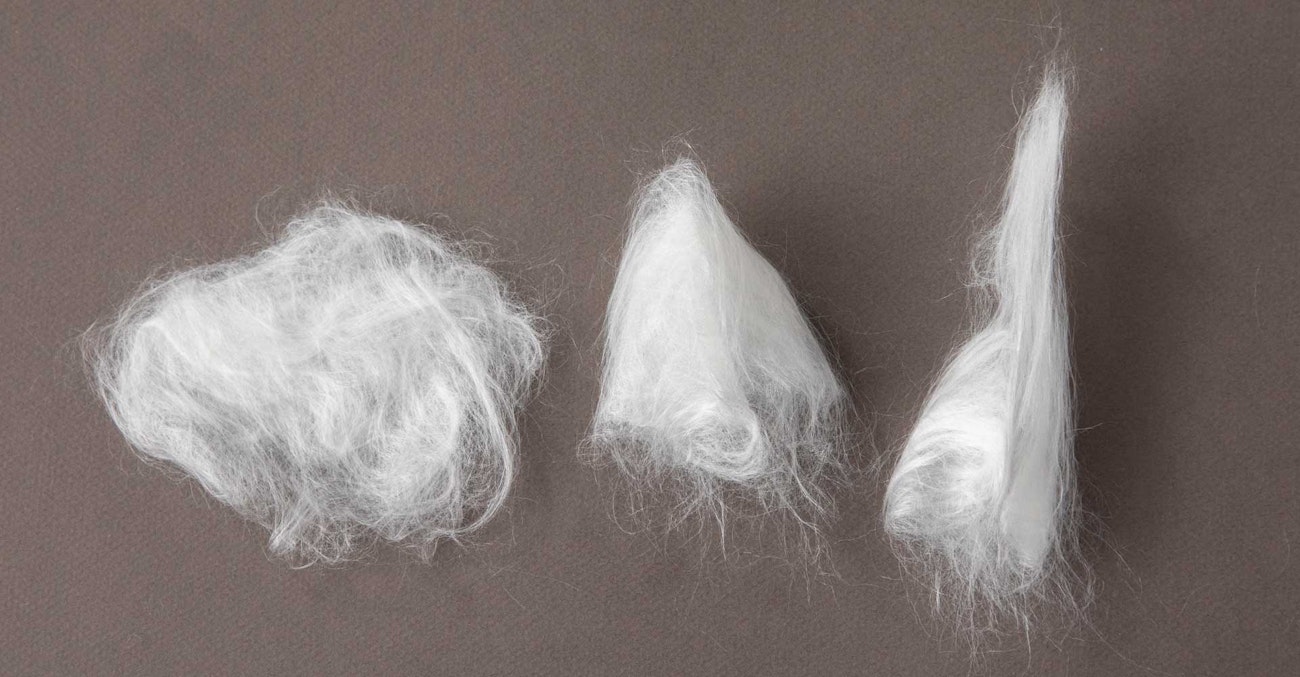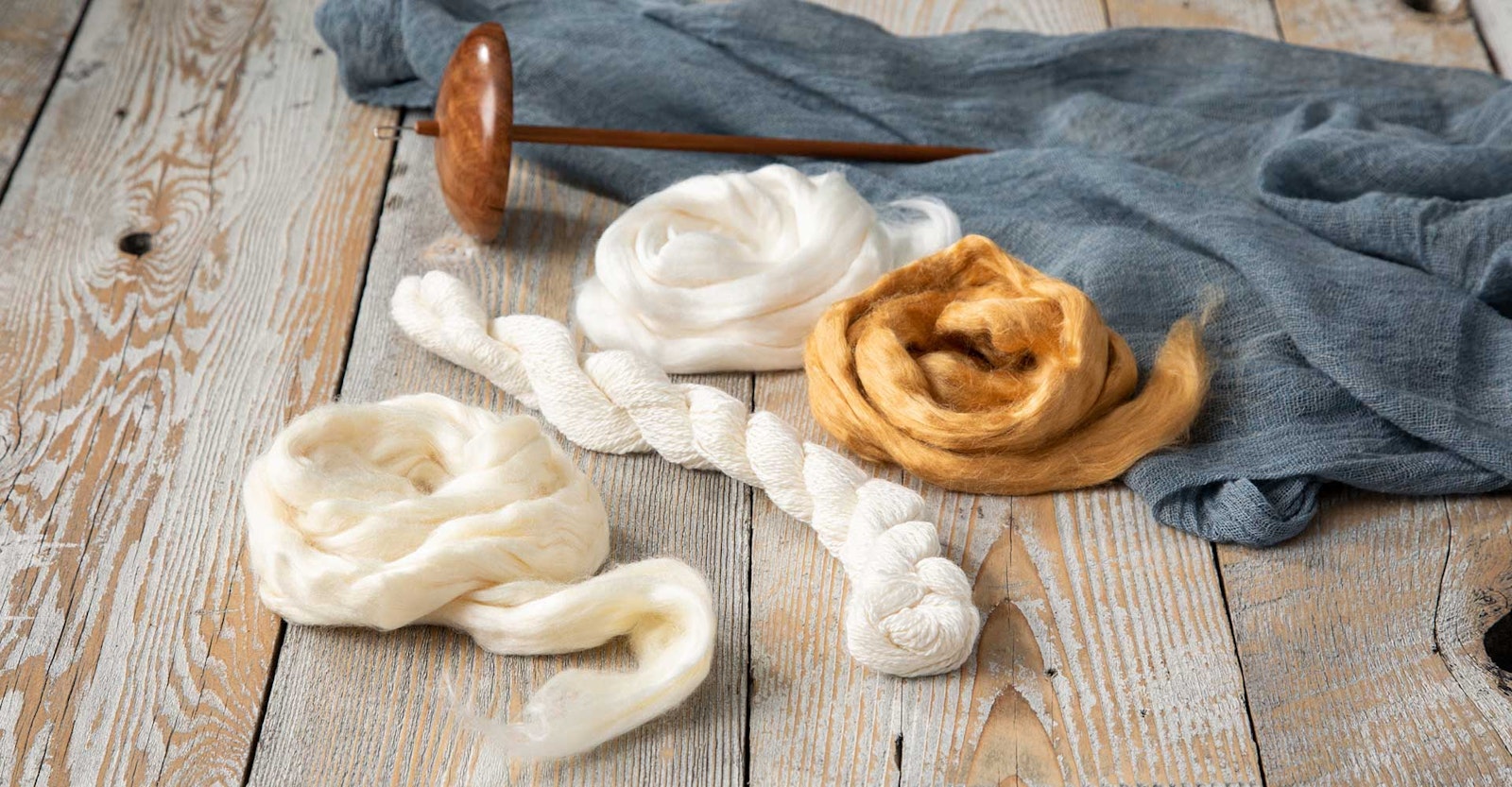Thirty-five years ago, the eri silk I was able to purchase felt, looked, and behaved more like cotton than it did silk. But with advances in the technology used at a commercial scale, the eri silk sliver available today is quite different. Improved degumming and fiber preparation techniques have resulted in an eri silk sliver with a soft, cashmere-like hand and a delicate pearlescent sheen. I enjoy working with eri because it is almost as fine as bombyx silk, but unlike bombyx, eri blends readily with other fibers.
One of my challenges with this new and improved commercial fiber preparation was to find a way to preserve the fiber’s luster, and at the same time, manage the fine, slick, and slippery fiber. My solution is to manipulate the fiber to form what I call a tussie mussie, which is simply an organized way of arranging and loosening the commercial sliver to give the spinner more control.
 A tussie mussie is a portable, miniature, cone-shaped flower vase, popular in the Victorian era. Tussie refers to a small flower bouquet, and mussie refers to the moistened moss wrapped around the stems to prevent the flowers from wilting. The fiber preparation method described here is cone-shaped like a tussie mussie and is composed of a crisscrossed web of silk reminiscent of the delicate filigree design common to Victorian aesthetic. Photo by Kim McKenna
A tussie mussie is a portable, miniature, cone-shaped flower vase, popular in the Victorian era. Tussie refers to a small flower bouquet, and mussie refers to the moistened moss wrapped around the stems to prevent the flowers from wilting. The fiber preparation method described here is cone-shaped like a tussie mussie and is composed of a crisscrossed web of silk reminiscent of the delicate filigree design common to Victorian aesthetic. Photo by Kim McKenna
At first blush, you might think fiber spun from a silken tussie mussie would tangle horribly and result in an awful mess. Instead, the silky eri fibers simply float past one another as you draft. If you think about it, this fiber preparation is not too far a stretch from either what we know as “cloud,” or the careful fanning and layering of flax when dressing a distaff, or even the spinning draft known as spinning “from the fold.” Tussie mussies work well as a fiber preparation for spinning on either wheels or spindles.
It is true that this additional preparation method takes more time than simply spinning from the fold or directly from a sliver, but I find it is time well spent for the types of yarns I am making. Redistributing the fibers and creating a crisscross orientation that reins in those slippery fibers gives me more control. This allows me to spin finer, more consistent singles faster.
I find that this also keeps fibers in check during spinning; the ends do not waft away from the apex of the drafting triangle as they do when I spin from the full width of silk sliver. I encourage you to give this technique a try with either worsted or woolen spinning drafts.
How to Prepare a Tussie Mussie
I am right-handed. If you are left-handed, you may find it easier to transpose these instructions. Also, working on a smooth surface will prevent the fine strands of eri from snagging as you guide the silk across the surface. I use my leather lap cloth, smooth side up.
Depending on how the eri cocoons are processed, the commercial slivers available contain either very short (½ to 1 inch) or medium-long to extralong (4 to 6 inches) staple lengths. I developed this fiber-preparation technique for commercial silk slivers with longer staple lengths.

Step 1
Pull the sliver into short sections, about the length of your hand. Open up the fibers on the left-hand side of the sliver. With the side of your left hand (or index finger and base of your thumb if it works better), hold the open wisps of fiber firmly against the surface while the right hand pulls the length of fiber across the surface. This leaves a thin veil of silk fiber in its wake as you move your right hand from left to right. Stop once you have spread out a wisp of fiber approximately 6 inches wide.

Step 2
Transfer the fiber supply to your left hand. Hold the right edge of the veil of fiber with your right hand and pull the fiber to your left. These two layers complete one pass. Repeat these steps to create a second complete pass.

Step 3
After you have completed two passes, set the resulting “cake” of silk aside. From one length of silk, I usually get three or four cakes. Once I have eight cakes prepared, I move on to the next step and start spinning. More would be better because they spin up quite quickly, but I can never wait to start spinning this beautiful fiber.

Step 4
To prepare the cake for spinning, pinch the fiber in its center and pull up. This results in a cone-shaped mass of crisscrossed fibers. Spin from the apex of the cone and you are away to the races. To join a new tussie mussie, I pull about an inch and a half of fiber from its apex and lay the wispy strand on top of the tuft remaining from the previous tussie mussie.
Spinning
Tussie mussies work equally well when spun with a short-forward worsted, short-backward worsted, or woolen draft. They are a lovely fiber preparation for spinning eri on a wheel, suspended spindle, or supported spindle when consistency and control are vital.
When spinning any silk with my wheel, I add just enough tension to the brake band to wind the singles onto the bobbin. If I want to slow down the take-up the tiniest bit, instead of adjusting the brake band, I will first try cross-lacing the singles on the flyer. If that is not enough, then I will adjust the brake band.

From left: Start with a thin sheet of silk layers, pinch the center and pull into a cone shape, and then begin drafting from the tip.
If you prefer to spin a smoother, finer yarn, you can modify the cone shape a bit. After you pinch the middle of the cake and pull up, fold the cake in half as if closing a book to create a flattened, roughly triangular shape. Starting at the apex and working toward the base, gently draft the fibers into a length of roving. For extremely fine, consistent spinning, try creating tussie mussies made from one complete pass instead of two.
If you are looking for an enjoyable spin that results in handspun with a lovely soft hand, excellent drape, and exquisite luster, I suggest you add some eri silk to your fiber repertoire.
And if you’re a Spin Off subscriber, you can see this method in action here.
Resources
Wardle, Thomas. Handbook of the Collection Illustrative of the Wild Silks of India, in the Indian Section of the South Kensington Museum. London: G. E. Eyre and W. Spottiswoode, for H. M . Stationery Office, 1881.
This article was first published in Spin Off Winter 2023.
Also, remember that if you are an active subscriber to Spin Off magazine, you have unlimited access to previous issues, including Winter 2023. See our help center for the step-by-step process on how to access them.
Curiosity is what propels Kim McKenna. She is constantly learning and improving upon her handspun yarn. Kim shares her learning through virtual workshops with Sanjo Silk and in-person workshops through Coniagas Fleece and Handspinning School and SweetGeorgia Yarns, as well as through the School of SweetGeorgia. You can follow her journey at claddaghfibrearts.com and on Instagram @claddaghfibrearts.

